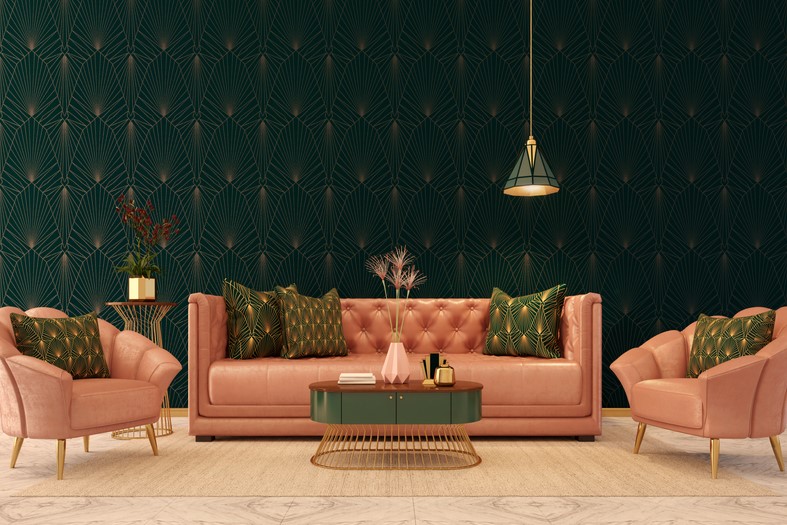Millennial gray swept through many interiors during the minimalist movements of the 2010s as millennials attempted to counteract the gaudy and beige interiors of their parents. Today, millennials are transitioning away from gray to green. The swap seems to be inspired by new biophilic interiors, old-money aesthetics, and cottagecore looks.
Sage, olive, and forest green tones are trending everywhere. But is it becoming tacky and overrated? We weigh in on what you need to know about millennial green.
What is millennial green?

Millennial green isn’t any particular shade of green. Instead, “millennial green” refers to the abundant usage of several different green tones cropping up in interiors. Millennial green adds colors like sage, olive, forest green, evergreen, emerald, and pastel green to our spaces.
The trend has been a recent development in response to the pushback of millennial gray. During the 2010s, as minimalist, brutalist, and industrial aesthetics thrived, gray became a go-to color for many millennials. Gray replaced beige, which was the ’90s and early 2000s beige “it” color. However, around 2020, gray became known as a sad and drab color. In response, paired with the surge of new interior styles, millennials shifted from gray to green. Now, we’re seeing green hues everywhere in millennial interiors.
Where are people adding green in the home?

Like millennial gray, millennial green isn’t just turning up as a wall color. Rather, millennials are getting creative and adding this lush and lively color to many different areas of the home.
Kitchen cabinets
A popular use of green is to paint the kitchen cabinets. Millennials who adore vintage and farmhouse aesthetics have leaned into green kitchen cabinetry. Sage and pastel green tend to be the most popular, but we’ve also seen some stunning dark green cabinets.
Velvet green sofa
Green is a classic color for old-money aesthetics, and it’s no surprise that this style has influenced how millennials add green to their spaces. The green velvet sofa will likely go down in history as a notable interior design piece, defining the 2020s millennial aesthetic. Green velvet sofas are everywhere. Paired with dark wood tones, gold metallics, and rich leather accents, the green velvet sofa is a staple of the old-money look.
Green wainscoting
Wainscoting is trending in homes across the world, becoming another popular interior addition in the 2020s. Wainscoting is practically a millennial must-have, adding depth and dimension to walls and creating the perfect opportunity for two-tone palettes. Many millennials are painting their wainscoting green. Sage and olive tones are the most common, but some darker hues have been used as well. Pair green wainscoting with a light floral wallpaper, and you can achieve the perfect millennial cottage aesthetic.
Green tiling in bathrooms and kitchens
Green is also making its way into bathrooms and kitchens. While less common, some millennials are switching up their existing tiles for green variants. For example, we’re seeing green color-drenched and tile-drenched bathrooms. Another interesting choice is the use of green handmade tile backsplash in the kitchen.
Dark green bedroom
Moody bedrooms with dark hues fit for sleep are gaining more traction. As millennials shift away from gray and white, they’ve begun using green as a base for their color palette. Dark green colors like emerald, jade, and evergreen have been trendy choices for the bedroom. Painting the ceiling and doors the same color is also trending.
The best colors to pair with green

Green is organic, biophilic, and riveting. If you’re inspired to use this color in your home, here are some great pairings for a green color palette.
Dark wood tones
Green of any hue, whether sage or emerald, looks stunning alongside dark wood tones. Many light wood tones have begun to look outdated as homeowners and designers shift to darker alternatives. Pair green spaces with dark oak, walnut, or mahogany for a rich and luxe look.
Warm cream
If you want to lighten or brighten a darker green palette, we recommend using warm cream. This color is especially impactful if it has brown, red, or yellow undertones. Warm cream and sand tones look organic and natural alongside green. If you want a more biophilic aesthetic, add warm cream to a green palette.
Burnt orange
Another trending color among millennials is burnt orange. This hue is often paired alongside green but stands on its own as a fun, vibrant, and kitsch addition to any space. Millennials likely find burnt orange to be reminiscent of childhood aesthetics, and therefore, crave the color in their spaces. Alongside green, it adds a playful touch to any palette.
Gold accents
Gold accents are a must-have in a green color palette. Green and gold were practically made for each other, and it’s never more evident than when you see a green velvet backdrop paired with gold metallic accents. If you have a green velvet sofa, choose decor pieces with gold metallics. Lean into the old-money vibe when working with these two colors.
Is millennial green overrated?

While some argue that millennial green is just a phase and will soon be overrated like millennial gray, many homeowners and designers love the color change. Green is a luxe, organic hue, perfect for nearly any home. Whether some say it’s outdated or not, it truly comes down to personal preference.
If you love green and want to use it in your space, you don’t have to follow the trends. Simply curate the palette that best suits your tastes, even if the color is a tad overrated.




